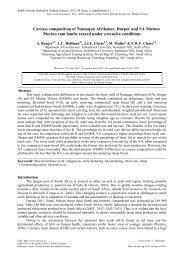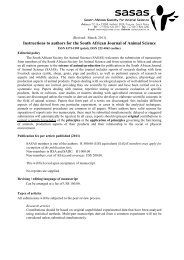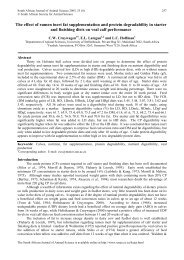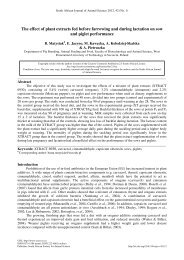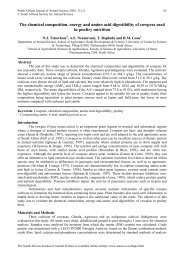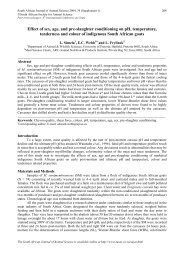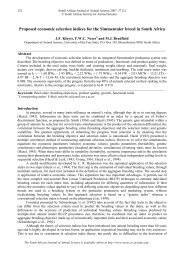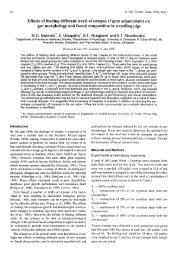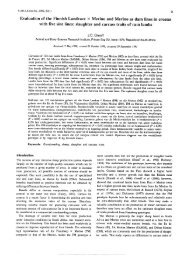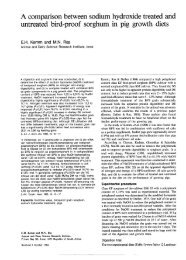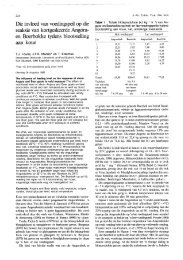Sensory and objective mutton quality characteristics of SA - African ...
Sensory and objective mutton quality characteristics of SA - African ...
Sensory and objective mutton quality characteristics of SA - African ...
Create successful ePaper yourself
Turn your PDF publications into a flip-book with our unique Google optimized e-Paper software.
South <strong>African</strong> Journal <strong>of</strong> Animal Science 2003, 33 (1)<br />
© South <strong>African</strong> Society for Animal Science<br />
58<br />
line effect on meat tenderness. The positive line group had higher (P ≤ 0.05) WBS values, indicating that<br />
meat derived from the positive line is less tender compared to the meat from the negative line.<br />
Table 7 Means <strong>of</strong> pH 48 , drip loss, cooking loss <strong>and</strong> shear force resistance <strong>of</strong> lamb<br />
M. longissimus dorsi as influenced by line <strong>and</strong> sex<br />
Line<br />
Sex<br />
Positive Negative LSD c Ram Ewe LSD<br />
pH 48 5.67 5.73 NS d 5.80 a 5.61 b 0.09<br />
Drip loss (%) 1.28 1.33 NS 1.18 1.43 NS<br />
Cooking loss (%) 27.83 27.47 NS 30.72 27.77 NS<br />
WBS e (N) 137.3 a 112.4 b 18.66 101.0 b 148.8 a 18.66<br />
a,b Means in the same row with different superscripts are significantly different (P ≤ 0.05)<br />
c<br />
Least significant difference (P = 0.05)<br />
d Not significant (P > 0.05)<br />
e Warner Bratzler shear force value<br />
Conflicting reports regarding the relationship between pH <strong>and</strong> tenderness (WBS <strong>and</strong> sensory<br />
tenderness) are found in the literature. Young et al. (1993) showed a curvilinear relationship between pH <strong>and</strong><br />
WBS values, while Safari et al. (2001) found no relationship between pH <strong>and</strong> WBS or tenderness in four<br />
lamb genotypes. No significant correlations were found in this investigation.<br />
Results from this study indicated differences (P ≤ 0.05) between the four groups involved in the line x<br />
sex interaction regarding the Ca, Fe, K, Mg, P <strong>and</strong> Zn concentrations (Table 8). The major contributors to the<br />
mineral concentration <strong>of</strong> the <strong>mutton</strong> were K (±122 mg/100 g meat sample) <strong>and</strong> P (ca. 110 mg/100 g meat<br />
sample). There was a general tendency for the PE group to have the highest mineral concentration, except for<br />
Zn <strong>and</strong> Cu, whereas the NE group had the lowest concentration in all the minerals, except for Se.<br />
Table 8 Means for mineral composition <strong>of</strong> M. semimembranosus as influenced by the<br />
interactions between the main effects <strong>of</strong> line <strong>and</strong> sex (mg/100 g meat sample)<br />
Line Positive Negative<br />
Sex Ewe Ram Ewe Ram LSD c<br />
Ca 6.498 a 5.792 a 3.347 b 4.622 ab 2.420<br />
Fe 1.828 a 1.747 a 1.108 b 1.335 ab 0.575<br />
Se 0.087 0.054 0.067 0.054 NS<br />
K 134.5 a 128.1 ab 99.63 b 126.9 ab 28.73<br />
Mg 19.15 a 18.13 ab 14.93 b 16.57 ab 3.998<br />
Na 17.56 17.76 13.36 17.29 NS<br />
P 124.1 a 117.1 a 92.02 b 107.7 ab 24.49<br />
Zn 2.717 a 2.966 a 2.077 b 2.403 ab 0.583<br />
Cu 0.003 0.012 tr e 0.028 NS<br />
Pb 0.007 0.001 tr 0.003 NS<br />
a,b Means in the same row with different superscripts are significantly different (P ≤ 0.05)<br />
c<br />
Least significant difference (P = 0.05)<br />
d<br />
NS = Not significant (P > 0.05)<br />
e trace = < 0.001 mg/100 g meat sample<br />
When pooled together across sexes for positive <strong>and</strong> negative reproduction groups (Table 9), positive<br />
line animals had higher concentrations <strong>of</strong> Ca, Fe, P <strong>and</strong> Zn than their negative line contemporaries. Rams<br />
<strong>and</strong> ewes did not differ with regard to mineral concentrations.<br />
The South <strong>African</strong> Journal <strong>of</strong> Animal Science is available online at http://www.sasas.co.za/Sajas.html



